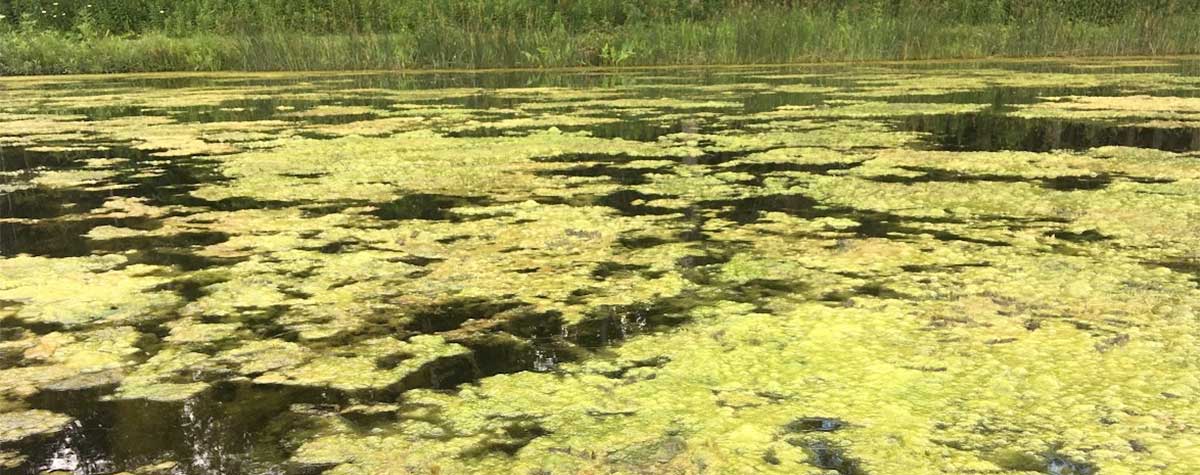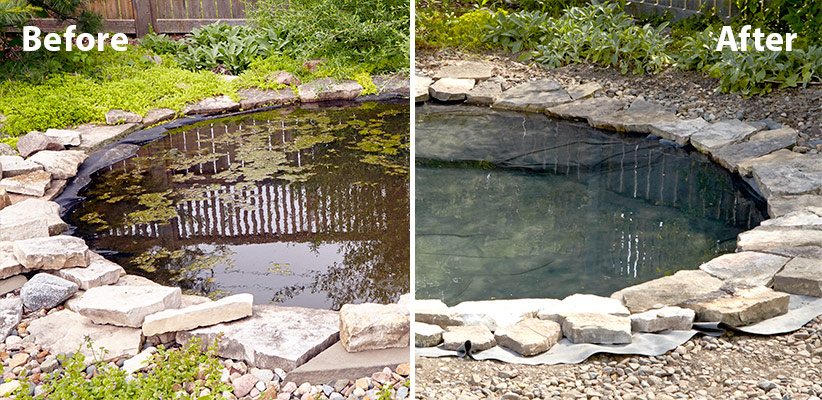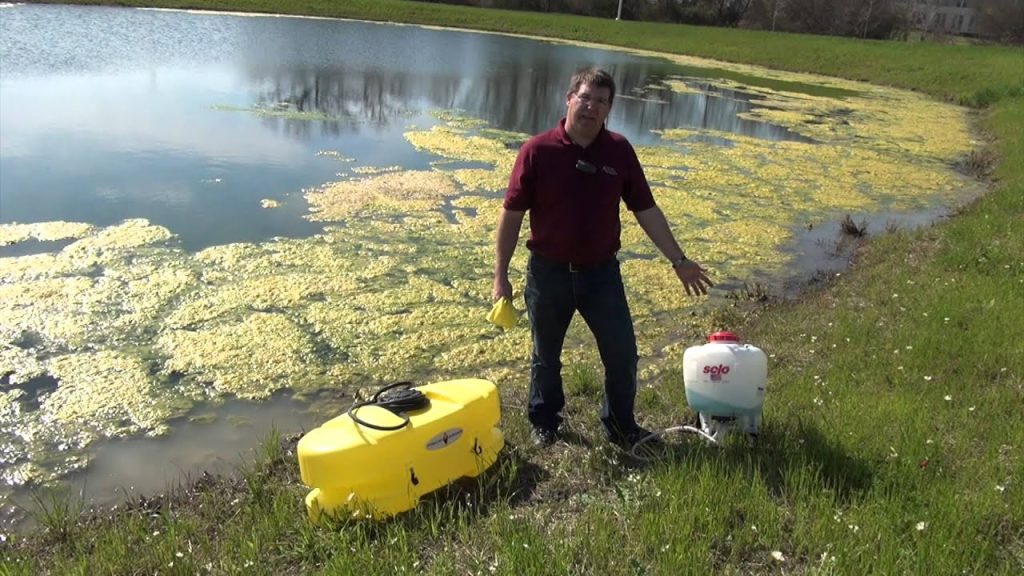To get rid of algae in a large pond, use algae treatment products or employ natural methods such as adding beneficial bacteria, increasing aeration, and reducing nutrient levels in the water. Large ponds can be beautiful additions to any landscape, providing a serene backdrop for relaxation and recreation.
However, algae accumulation can quickly turn a visually appealing pond into an unsightly, green mess. Algae growth is typically caused by high nutrient levels and low oxygen levels in the water, which create the perfect environment for algae to thrive.
While eliminating algae can be a challenging task, it is not impossible with the right approach. We will explore various methods to effectively get rid of algae in a large pond, restoring its natural beauty and preventing future growth.

Credit: www.pondexperts.ca
Identifying Algae In Your Large Pond
Identifying Algae in Your Large Pond is crucial for effective removal. By Recognizing Algae Types and Assessing Algae Growth, you can tackle this issue head-on.
Recognizing Algae Types
There are different types of algae that can be present in your pond, each requiring specific treatment methods. The common types include:
- Green algae – usually float on the surface and give the water a green tint.
- String algae – appear as long, stringy strands that can entangle aquatic plants.
- Blue-green algae – often form dense mats on the water’s surface and can be harmful to fish and other aquatic life.
Assessing Algae Growth
Monitoring the growth of algae is essential to determine the severity of the issue. You can assess algae growth by:
- Observing the color and texture of the algae present in your pond.
- Measuring the coverage area of algae on the water’s surface.
- Checking for any foul odors or abnormal changes in water clarity.

Credit: harriettahills.com
Natural Methods For Controlling Algae
Introducing Aquatic Plants
Aquatic plants play a crucial role in reducing algae growth by competing for nutrients and providing shade in the pond.
Using Beneficial Bacteria
Beneficial bacteria help break down organic matter and nutrients that algae thrive on, leading to a healthier pond ecosystem.
Mechanical Solutions For Algae Removal
If you’re dealing with algae in a large pond, considering mechanical solutions for algae removal is essential. These strategies are effective in physically eliminating algae from the pond, restoring its balance and clarity.
Implementing Aeration Systems
Aeration systems are a powerful tool for combating algae growth in large ponds. By introducing oxygen into the water, an aeration system can disrupt the conditions that favor algae proliferation. The increased oxygen levels also promote the growth of beneficial bacteria that can naturally consume excess nutrients, hindering algae growth.
Installing Pond Skimmers
Pond skimmers can be a valuable addition to your mechanical arsenal for combating algae in large ponds. These devices work by drawing in water from the surface, which helps remove floating debris, organic matter, and algae before they have a chance to settle and contribute to further algae growth. By facilitating the physical removal of algae, pond skimmers aid in maintaining a healthier pond environment.
Chemical Treatments For Algae Elimination
When it comes to getting rid of algae in a large pond, chemical treatments can be effective solutions. Understanding how to use algaecides and copper-based solutions is crucial for successful algae elimination.
Understanding Algaecides
Algaecides are chemical compounds specifically designed to kill or prevent the growth of algae. They work by disrupting the cellular functions of algae, ultimately leading to their removal. Algaecides are available in various forms, including liquid, granular, and tablets. Before choosing an algaecide, it’s important to consider factors such as the types of algae present in your pond and potential harm to desirable plants and fish.
Applying Copper-based Solutions
Copper-based solutions are another effective option for controlling algae in large ponds. Copper is toxic to algae and inhibits their growth. These solutions typically come in liquid or granular form and should be spread evenly over the pond. It’s important to follow the manufacturer’s instructions when applying copper-based solutions, as excessive use may harm fish and other aquatic organisms. Regular maintenance and monitoring are necessary to ensure the copper levels remain within the recommended range.
Maintenance Practices To Prevent Algae Regrowth
To prevent algae regrowth in large ponds, implement regular maintenance practices. This includes limiting excessive nutrients, managing water flow and oxygen levels, using algae control products, and maintaining a proper balance of aquatic plants and fish. Clean the pond regularly to remove any debris and maintain water quality.
Proper Pond Filtration
Proper pond filtration is one of the most effective ways to prevent algae regrowth in a large pond. Filtration systems are responsible for removing impurities, excess nutrients, and organic matter from the water, which are often the main culprits behind algae blooms. When choosing a filtration system, there are a few key factors to consider: 1. Type of Filtration: There are several types of pond filters available, including biological filters, mechanical filters, and UV clarifiers. Each type serves a specific purpose in maintaining water clarity and quality. 2. Adequate Filtration Capacity: It’s crucial to select a filtration system with the capacity to handle the size of your pond. The filter should be able to process the entire volume of water multiple times per hour for optimal results. 3. Regular Maintenance: Filtration systems require regular cleaning and maintenance to ensure they function properly. This may include rinsing or replacing filter media, cleaning out debris, and checking the condition of any UV bulbs. Investing in a high-quality filtration system and maintaining it regularly will go a long way in preventing algae regrowth in your large pond.Regular Water Quality Testing
Regular water quality testing is another essential maintenance practice to prevent algae regrowth. Testing the water helps you monitor key parameters and identify any imbalances that could promote the growth of algae. Here are a few important factors to test and monitor: 1. pH Levels: Algae tend to thrive in water with a high pH, so it’s important to monitor and adjust pH levels if necessary. The optimal pH range for most ponds is between 7.0 and 8.5. 2. Nutrient Levels: Excess nutrients, such as nitrogen and phosphorus, can fuel algae growth. Conduct regular tests to measure nutrient levels and take appropriate action if they’re elevated. This may involve reducing fertilizer use, adding beneficial bacteria, or implementing nutrient-sequestering plants. 3. Ammonia and Nitrite Levels: High levels of ammonia or nitrite can be harmful to fish and create an ideal environment for algae. Test for these compounds regularly and mitigate any issues that arise. By regularly testing the water quality and adjusting as needed, you can proactively prevent algae from regrowing and maintain a healthy, balanced ecosystem in your large pond. Incorporating these maintenance practices into your pond care routine will significantly reduce the chances of algae regrowth and promote a thriving aquatic environment. Keep in mind that prevention is key, and being proactive in maintaining your pond’s filtration system and water quality will save you time, effort, and frustration in the long run. Take the necessary preventive measures, and enjoy a beautiful, algae-free large pond year-round.
Credit: www.gardengatemagazine.com
Professional Services For Long-term Algae Management
When dealing with persistent algae issues in a large pond, seeking professional services can be a highly effective solution. Consulting aquatic specialists and hiring pond maintenance companies are both viable options for long-term algae management. These professionals possess the expertise and resources needed to implement strategic measures that prevent the recurrence of algae over the long term.
Consulting Aquatic Specialists
Consulting aquatic specialists can provide invaluable insights and recommendations for effectively managing algae in a large pond. These experts possess in-depth knowledge of aquatic ecosystems and can conduct thorough assessments to determine the underlying causes of algae overgrowth. By leveraging their expertise, pond owners can gain a comprehensive understanding of the specific environmental factors contributing to algae proliferation, enabling them to implement tailored strategies for long-term management.
Hiring Pond Maintenance Companies
Hiring pond maintenance companies offers a practical solution for pond owners seeking professional assistance in addressing algae issues. These companies are equipped with the necessary equipment, tools, and expertise to execute comprehensive algae management strategies. From implementing aeration systems to applying algae-controlling agents, pond maintenance companies can offer a holistic approach to effectively managing algae over the long term.
Regulatory Considerations For Algae Control
When it comes to maintaining a large pond, regulatory considerations for algae control are vital. It is essential to follow guidelines and regulations to ensure proper and effective methods for getting rid of algae in the pond. Implementing the right techniques will ensure a healthy and balanced ecosystem for the pond.
Understanding Environmental Impact
Evaluate the impact of algae control methods on ecosystem balance.
Complying With Local Regulations
Research and adhere to local laws on algaecide usage. Consult with authorities if necessary.
Conclusion And Future Algae Prevention
Preventing algae growth in large ponds involves implementing natural solutions like adding beneficial bacteria enzymes. Regular maintenance and limiting nutrient buildup are key in controlling algae and ensuring a clear pond for the future. Promoting a balanced ecosystem helps maintain water quality and biodiversity.
Implementing A Comprehensive Strategy
Regularly monitor water quality with test kits to maintain balance.
- Limit nutrient influx by reducing overfeeding of fish
- Install aeration systems to boost oxygen levels in the pond
- Introduce beneficial pond plants to compete with algae for nutrients
Sustaining A Healthy Pond Ecosystem
By incorporating beneficial bacteria to control algae growth.
- Ensure proper filtration system maintenance
- Regularly clean debris and decaying matter from the pond
- Consider using natural algaecides or UV sterilizers if necessary
Conclusion
In order to maintain a healthy and clear large pond, it is essential to regularly clean, maintain proper circulation, and consider using natural plants or algaecides. By incorporating these methods, you’ll be able to effectively control and prevent algae growth, creating a balanced ecosystem for aquatic life to thrive.





